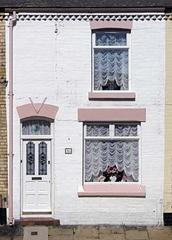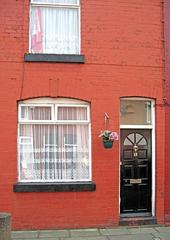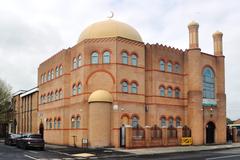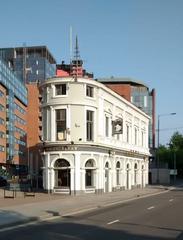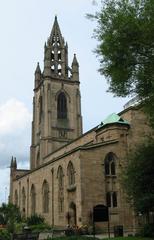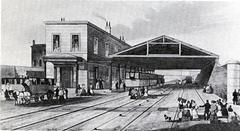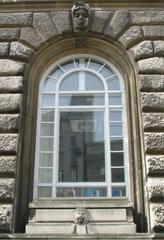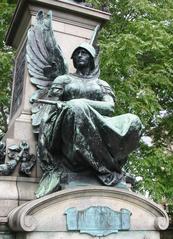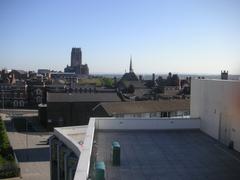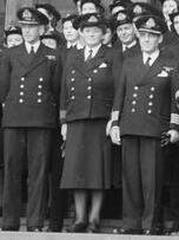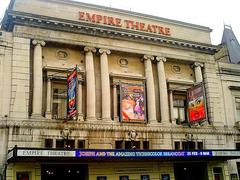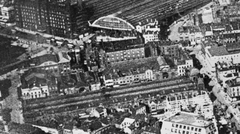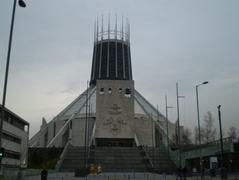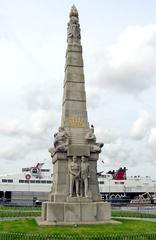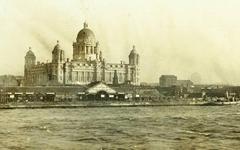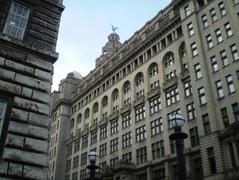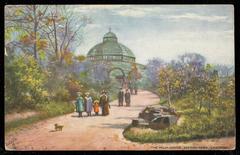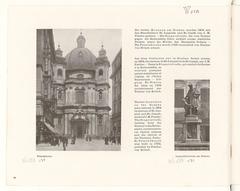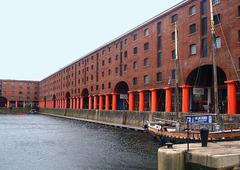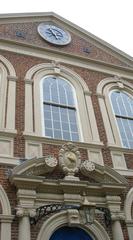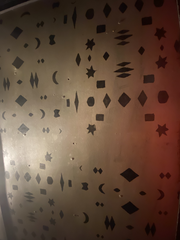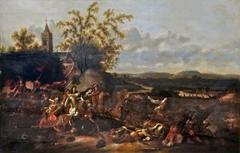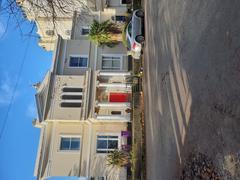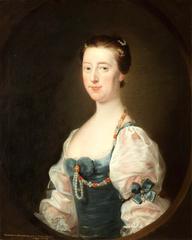Calderstones House Liverpool: Visiting Hours, Tickets, and Historical Sites Guide
Date: 04/07/2025
Introduction: History and Cultural Significance
Calderstones House, set within the leafy Calderstones Park in South Liverpool, is a striking emblem of the city’s layered heritage. Built in 1828 for Joseph Need Walker, a prosperous merchant, this Grade II listed neoclassical mansion reflects the wealth and aspirations of Liverpool’s Georgian and early Victorian elite. Yet Calderstones House is remarkable not only for its architecture but also for its unique connection to the region’s ancient past, notably through the Calder Stones—six Neolithic sandstone boulders dating back 4,000–5,000 years. These stones are among the oldest man-made structures in Merseyside, offering visitors a tangible link to Liverpool’s earliest settlers and its enduring evolution as a global city.
Today, Calderstones House is managed by The Reader charity and serves as a thriving cultural and community hub. The mansion has been thoughtfully restored, providing accessible experiences for all visitors. Guests can explore the “Calderstones Story” exhibition, relax in the Reader Café and Bookshop, enjoy open-air performances in the restored Art Deco Garden Theatre, or participate in family-friendly workshops at the Storybarn. The House’s inclusive environment welcomes everyone, whether you’re interested in history, culture, family activities, or community well-being.
This comprehensive guide will help you plan your visit to Calderstones House, covering everything from visiting hours and ticket info to guided tours, accessibility, and nearby attractions. Further details are available from The Reader’s official website and Liverpool History Society.
Table of Contents
- Origins and Early History
- Architectural Significance
- Social and Economic Context
- Public Ownership and Parkland
- Community Events and Cultural Role
- Heritage Interpretation and Education
- Visiting Hours, Tickets, and Accessibility
- Directions and Nearby Attractions
- Visuals and Interactive Media
- Ongoing Research and Engagement
- Architectural Conservation and Modern Use
- Significance in Local Heritage
- Frequently Asked Questions (FAQ)
- Plan Your Visit
Origins and Early History
Calderstones House, sometimes called the Mansion House, stands at the heart of Calderstones Park. The park’s name derives from the ancient Calder Stones—six Neolithic boulders thought to be the remains of a prehistoric burial chamber, dating back up to 5,000 years. These stones, relocated to a protective glasshouse, are among the region’s most important archaeological finds (The Reader: The Calderstones Story).
The mansion itself was completed in 1828 for Joseph Need Walker, a wealthy merchant and lead shot manufacturer. Designed as a grand private villa, the Mansion reflected the prosperity of Liverpool’s burgeoning merchant class during a period of rapid urban expansion.
Architectural Significance
Calderstones House exemplifies early 19th-century neoclassical design, featuring a stuccoed brick structure, symmetrical façades, sash windows, and a prominent portico with Ionic columns. Its graceful proportions echo the tastes of the era, and the building stands as a rare surviving example of a suburban villa from Liverpool’s golden age. Its Grade II listed status underlines both its architectural and historic importance (LiverpoolWorld: Grade II listed Mansion House).
Social and Economic Context
The Mansion House’s legacy is intertwined with Liverpool’s rise as a trading powerhouse. Much of the wealth that built such grand homes originated from commerce, including the transatlantic slave trade. Between 1695 and 1807, Liverpool merchants financed thousands of slave voyages, shaping both the city’s social fabric and its built environment. While direct links between Calderstones House and the slave trade remain under research, the context is integral to understanding Liverpool’s development (The Reader: Calderstones Park and its links to slavery).
Public Ownership and Parkland
By the early 20th century, the estate lands around Calderstones House were gradually sold for development. In 1902, Liverpool City Council acquired the house and grounds, opening the park to the public in 1905. This marked the Mansion’s transformation from private residence to public asset—a reflection of shifting attitudes towards green spaces and heritage preservation. Since then, the park has become a beloved escape for locals, and the Mansion has served as a tea room, event venue, and, more recently, the home of The Reader (The Reader: Events at Calderstones).
Community Events and Cultural Role
Calderstones House has long been at the heart of community life. During World War II, the park played a role in the local war effort and community gatherings. Today, the Mansion is a centre for cultural activity, offering shared reading sessions, creative workshops, outdoor theatre, and heritage exhibitions (The Reader: Events at Calderstones). Initiatives like the “Oaks at 80” project commemorate the end of WWII through tree planting, blending environmental stewardship with remembrance (LiverpoolWorld: Oaks at 80).
The restored 1940s Garden Theatre hosts open-air performances and community events, celebrating Calderstones House’s heritage and its ongoing role in Liverpool’s cultural life.
Heritage Interpretation and Education
The “Calderstones Story” exhibition inside the Mansion presents the site’s history, from the Neolithic era to the present. This immersive display combines archaeological finds, archives, and personal narratives (The Reader: The Calderstones Story). Heritage and literature trails, accessible via QR codes, encourage exploration and learning for all ages (The Reader: Trails & Tales).
Visiting Hours, Tickets, and Accessibility
- Opening Hours: Typically Thursday–Sunday, 10:00 AM–4:00 PM (some sources note daily opening; always check the official website for seasonal updates).
- Tickets: Entry is free; guided tours are available on select days and can be booked in advance.
- Accessibility: Step-free access, accessible restrooms, and mobility scooter use are available. Assistance dogs are welcome.
Directions and Nearby Attractions
Calderstones Park is in South Liverpool, easily reached by train (St Michaels station, 10-minute walk), bus, or car (free on-site parking). Nearby attractions include Sefton Park, Croxteth Hall, and the UNESCO-listed Liverpool Maritime Mercantile City.
Visuals and Interactive Media
Virtual tours and high-quality images, such as “Calderstones House facade” or “ancient Calder Stones display,” are available on The Reader’s website. Downloadable maps help plan your visit.
Ongoing Research and Engagement
The Reader continues to investigate Calderstones House’s history, including its economic and social legacy. Community events—from reading groups to creative workshops—keep the Mansion at the heart of Liverpool’s cultural life (The Reader: Events at Calderstones).
Architectural Conservation and Modern Use
Sensitive restoration has preserved Calderstones House’s heritage while adapting it for modern needs. The Mansion hosts exhibitions, community events, private functions, and serves as a hub for reading and learning (The Reader: The Calderstones Story; AllEvents: Calderstones Park Events).
Significance in Local Heritage
Calderstones House encapsulates Liverpool’s journey from prehistory to modernity. Its continued use as a community and cultural centre demonstrates a commitment to inclusive, living heritage (The Reader: The Calderstones Story).
Frequently Asked Questions (FAQ)
What are the opening hours?
Thursday–Sunday, 10:00 AM–4:00 PM (confirm on the official site).
Is admission free?
Yes, but donations are welcome. Guided tours require advance booking.
Is the site accessible?
Yes—step-free access, accessible restrooms, and assistance dogs are provided for.
Are there guided tours?
Yes, available on select days; book in advance.
How do I get there by public transport?
St Michaels train station is a 10-minute walk away. Several bus routes serve the area.
What other historical sites are nearby?
Sefton Park, Croxteth Hall, and Liverpool’s UNESCO-listed sites.
Plan Your Visit
To experience Calderstones House’s rich history and vibrant community life, plan your visit through The Reader’s website. Download the Audiala app for guided tours and additional content on Liverpool’s historical sites. Stay updated via social media and related posts.
Calderstones House: A Liverpool Historical Gem
Calderstones House is a highlight of Liverpool’s heritage, blending neoclassical architecture, ancient history, and a thriving cultural scene. Built in 1828 for Joseph Need Walker and later owned by Charles MacIver, co-founder of the Cunard Line, the Mansion connects visitors to Liverpool’s industrial and maritime past (Liverpool History Society).
The Calder Stones: Prehistoric Roots
The six sandstone Calder Stones, dating back to around 3000 BC, are Liverpool’s oldest monuments and offer a fascinating glimpse into the Neolithic era. Housed in a dedicated enclosure, they are a must-see attraction (Liverpool Museums).
Practical Visitor Information
- Opening Hours: Wednesday–Sunday, 10:00 AM–4:00 PM (confirm online for changes).
- Tickets: Free entry; some events require advance booking or fees.
- Accessibility: Wheelchair accessible, with ramps and accessible toilets.
- Transport and Parking: Well-served by public transport; free parking on-site.
- Guided Tours and Events: Regular tours and outdoor theatre; check event calendars (The Reader).
- Family-Friendly: Storybarn and playgrounds for children.
Calderstones Mansion House: Restoration, Programming, and Visitor Guide
Restoration and Transformation
After years of closure and decay, Calderstones Mansion House has been revitalized by The Reader, transforming it into an accessible, vibrant space blending heritage with community engagement (The Reader).
Literature and Cultural Life
The Reader’s Shared Reading groups, yoga and wellbeing workshops, art classes, and local history tours foster community connections (The Reader). The “Calderstones Story” exhibition spotlights the ancient stones and Liverpool’s evolution (Secret Liverpool; Liverpool Echo).
Café, Bookshop, and Family Activities
Enjoy the Reader Café, Bookshop, and Ice Cream Parlour. The Storybarn hosts creative children’s sessions (Liverpool Echo).
Open-Air Theatre and Festivals
The Art Deco Garden Theatre hosts the 2025 open-air season, featuring Shakespeare, classics, and music (Arts City Liverpool; Liverpool Echo).
Visitor Essentials
- Hours: Daily, 10:00 AM–4:00 PM.
- Admission: Free; special events may require tickets (Secret Liverpool).
- Accessibility: Wheelchair accessible, with support available.
- Travel: Free parking; accessible by bus and train.
Calderstones Park: Liverpool’s Green Oasis
Calderstones Park spans 94 acres with historic gardens, the Allerton Oak (over 1,000 years old), a tranquil lake, and botanical collections (Liverpool City Council; LiverpoolWorld).
Attractions
- Harthill Botanical Gardens: Nearly 4,000 plant species (Secret Liverpool).
- Japanese and Old English Gardens: Peaceful themed areas.
- Calder Stones Enclosure: Learn about the prehistoric stones (Big Liverpool Guide; Real Journey Travels).
- Playgrounds and Miniature Railway: Linda McCartney Playground and Sunday railway rides.
- Storybarn: Interactive children’s centre (Liverpool City Council).
Facilities
- Food and Drink: Reader Café and Ice Cream Parlour (The Reader).
- Bookshop and Art Exhibitions: Local artists’ work on rotation.
- Sports: Tennis, walking trails, fishing (permit required).
Practicalities
- Park Hours: Open 24/7; facilities 10:00 AM–4:00 PM.
- Admission: Free; some events/tours may require tickets.
- Accessibility: Paved paths for wheelchairs and strollers.
- Transport: Multiple entrances and good public transport links.
Summary: Key Visitor Information and Recommendations
Calderstones House and Park offer a unique blend of ancient heritage, Georgian architecture, and vibrant contemporary culture. The fully accessible site, free admission, and diverse programming make it a must-visit for families, history enthusiasts, and culture seekers alike. Stay updated with virtual tours, downloadable maps, and event details via The Reader’s website and the Audiala app.
By exploring Calderstones House, visitors join Liverpool’s living history, engaging with both its past and its dynamic present (The Reader: Events at Calderstones; Liverpool Echo).
References
- The Reader: The Calderstones Story
- Liverpool History Society
- The Reader: Mansion House
- Liverpool City Council: Calderstones Park
- LiverpoolWorld: Grade II listed Mansion House
- The Reader: Events at Calderstones
- Arts City Liverpool: Open-Air Season
- Liverpool Echo: Calderstones Park Ice Cream Parlour
- Secret Liverpool: The Calderstones
